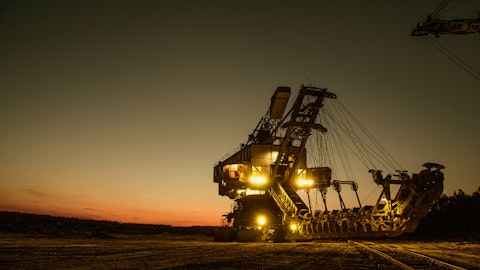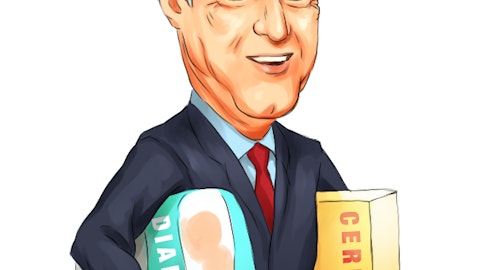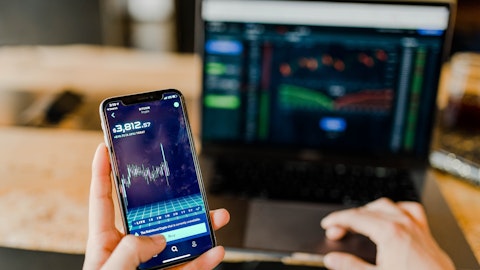Aaron Christiansen: Thanks, Susan. Happy to field that question. You know, as we’ve alluded to in prior quarters, service has been immensely challenged over the past year. One of our priorities has clearly been to restore service levels to historic levels. One of the ways we’ve done that is with very intentional and selective choiceful addition of inventory in the right places and our highest value added products to ensure that we can leverage our superior service as an advantage compared to our competitors and other customers.
Susan Kreh: Wonderful, thanks. With that, I’m going to wrap it up and actually turn it over to you, Aaron.
Aaron Christiansen: Thanks, Susan. Today I’d like to take a few minutes and I’m really excited to have the opportunity to talk about how Oil-Dri is investing in our future. We invest in many ways. We invest in our brands, we invest in our culture, we invest in our minerals and reserves, we invest in the environment, we invest in new products and innovation, and we invest in our teammates. Today, I would specifically like to talk about how we invest in our infrastructure. Oil-Dri is an 80-year business. Our producing facility is our foundation to what we do. I’m going to provide some really brief insight into our capital outlay, not in depth, but some examples of how we have invested and are continuing to invest in our facilities through our capital spend.
Both Susan and Dan have made comments and there’s a note in the disclosure and press release about our ongoing commitment. First, I’d like to talk about our philosophy. Any business finds itself with a continual conflict between investing in business growth endeavors, cost savings, and business continuity. And by business continuity, I mean savings, environmental compliance, safety, and the ongoing simple maintenance of our facilities. Oil-Dri looks for very intentional and intelligent ways to find investments that align with our growth strategy, but also deliver on cost compression and continuity of business. In fiscal 2022, Oil-Dri spent just less than $23 million. I believe there’s a question that’s been fielded in the portal. Susan alluded to it earlier.
We fully anticipate and expect investing in a very similar way, similar philosophy and similar level in the years ahead. Later today, you’re going to hear from several of our commercial leaders about our growth strategies in those areas, specifically in the area of litter and animal health. I’m going to take a few minutes and show some examples in these four areas of investments we have already made that deliver on all three; cost savings, business growth, and business continuity. I hope they’re insightful in ways that are meaningful to our investors. Before I talk in those, talk through those four areas, I’d like to talk about our mine operations. Oil-Dri at its core is a clay mining and minerals company. That is foundational to our business.
We make substantial investments every year in our mine assets and mine equipment. It is essential that day in and day out we can deliver clay to our factories in a way that’s reliable. We look for ways to do so that are more efficient, more modern each and every year. It is a continual commitment. I’d like to take a moment to also talk about how we reinvest in the land that we have leveraged and used. Oil-Dri has a substantial commitment to land reclamation every single year. You can see images on the screen here of land that we have mined and used. It’s been restored to hunting and fishing property, lakes and ponds that are used for the years ahead. Oil-Dri has an annual commitment to restore land that we used to its natural state. So now I’ll take a few minutes and talk about examples of where we’ve made investments in front of our growth agenda.
The first is the renewable diesel area. Oil-Dri has looked at ways to debottleneck our milling operations, prepare for the future years in advance and build capacity that we fully anticipate needing. We also take advantage to do so in manners that also improve our environmental footprint, reducing particulate matter and emissions. We’ve been able to leverage our environmental agenda at the same time that we deliver capacity for growth. Chris will talk shortly about lightweight cat litter. We are on a multi-year journey to add capacity, reduced cost, and modernized our lightweight cat litter packaging operations. It’s also an area we’ve invested in ways that are better for our teammates; modern robotics, line layouts, lighting, ways that make us an attractive employer for our teammates, and ultimately help build and develop the culture that we want to flourish in our producing facilities.
Thirdly, I’d like to talk about how we have and are investing in our agricultural products. What’s shown here is an image of investments made in one of our facilities that supports our highest value added agricultural products. We’ve used modern design techniques, 3D modeling, advanced methods to optimize design and construction and grow our producing base in ways that are rapid. We chose equipment selection that reduces maintenance costs long-term as well as electricity and utility costs so that we can reduce costs from those products and ultimately reduce both utility and repair costs. Lastly and you’ll be hearing from Dr. Wade Robey later, I’d like to talk about how we’ve invested in our animal health producing footprint. This is really the most transformational area over the last 12 months, and we expect it to be similar over the next year or two.
A very wide ranging scope of investments made a really fundamentally built to add capacity. We’ve added air handling capacity, which also shrinks our environmental footprint, automation and modern drying assets, sets that we’re prepared for the growth ahead instead of being behind the eight ball. Hopefully this has been insightful and has answered some questions that have been fielded on the portal about our plans in the years ahead. We continue to look many years into the future to make sure that we are well in advance of our commercial team’s plans to grow the business. Speaking of plans to grow the business, I’d like to hand the baton to Mr. Chris Lamson, who is our Group VP of Retail and Wholesale.
Christopher Lamson: Thanks a bunch, Aaron. Good to be with you all this morning. And we’re going to talk about staying the course and our focus on lightweight litter. I would have loved the double entendre if we were talking about staying the course with our coarse litter. And we feel good about that business, but really we see our growth coming in the lightweight litter business, both on the branded side and on the private label side. And Dan talked about may be and about a year into the role, and as I came in and looked at strategy, sometimes the new person wants to come in and candidly make a bunch of changes and really this presentation is about why we’re not. We’ll talk about a few new tactics and a few things that we’re excited about in terms of lifting both of our branded and our private label business.
But fundamentally, we are staying the course of private label because one highly consumer relevant. Who wouldn’t want all other things equal, who wouldn’t want a product that is a lot easier to shop for, a lot easier to handle at the point of consumption? Incredibly customer relevant, significantly lower cost than a freight laden business for our customers. And virtually all of our major customers are also driving environmental programs. It takes trucks off the road and we’re advantaged here. Our mineral is the best natural way to achieve lightweight litter. And in a couple slides the focus here is working, so we’ll share that as well. So again, a few tweaks, but we are staying the course in terms of our focus on lightweight litter. Overall a quick look at the growth in the overall cat litter business since 2018.
You see impressive compounded growth up at the top. I did a little math, what’s also impressive and I would think investors would want to take note of, the growth has been remarkably consistent here. And I think it ranges between 8.8% and 10.9% annually and it’s accelerating a bit with the last couple years up 9% and 11% year-on-year. So love the — love the consistency. Next slide would show us why I shared with you that we’re staying focused from a results perspective on lightweight. So you just saw the 10% CAGR or so on our total litter business. Our overall compounded growth on the lightweight business is 50% higher at 15%. And I would also share with you when you look here, also accelerating. So the 15 is, is in the 10 and driving solid growth year-over-year.
I will say if you’re looking at close details and Leslie would probably wants me to note this, this slide is looking at our U.S. business. The previous slide had the Canadian business on it, which is the difference in the two CAGRs. So why are we staying the course? It’s working. You see the growth here. So fundamentally most of our tactics are staying pretty darn similar to where we’ve been on lightweight growth with a couple of modest tweaks that are really centered around making sure that our activities and our investments, our activities on the consumer side, our activities relative to innovation benefit both our branded business as well as the private label lightweight business. Okay? So we’ll share with you our continued focus on base product performance, the end-to-end benefits that we drive with customers as we sell to customers in terms of why they should be driving lightweight at the shelf, our innovation that we’re really amping up hosting it both against our base and some innovatives both product and packaging ideas and how we’re moving from focusing on Litter For Good on our brand to lightweight at the center of our consumer messaging.





